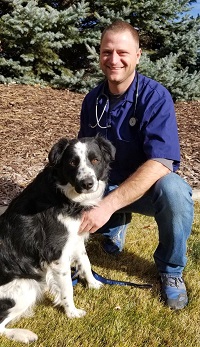As a dog owner, any change in your pup’s appearance is cause for concern. When a red, swollen spot appears, it’s important to take action, since it may be a sign of an infection.
So, what is a hot spot in dogs? Although hot spots might first look like an insect bite, they can quickly worsen and spread.1 Therefore, the goal is to identify an infected hot spot on dog before it takes on an alarming, sore-like appearance.
In this short guide, we’ll cover the steps to identifying and treating a dog hot spot so you can keep your furry friend in excellent health.
Identifying a Hot Spot
Infected hot spots, aka acute moist dermatitis, are the result of a bacterial infection.2 When your pooch has a skin irritation, they can worsen it through:
- Biting
- Excessive licking
- Scratching
If you notice your dog paying particular attention to an affected area on their body, it could be a sign that a hot spot is on the horizon.
Next, we’ll cover some of the warning signs that point to hot spots.
Is Your Pup Itching?
Understanding what causes hot spots in dogs is the first step to prevent hot spots from recurring. Has your pet been spending more time outside? Has summer brought hordes of mosquitoes and ticks to your area? Maybe your dog’s been in a new environment, perhaps on a camping trip or beach vacation.
If so, they could have been exposed to an insect bite or environmental irritant.
While we all itch from time to time, scratching can eventually make the problem worse (and more painful). Keep your eyes peeled for upticks in behavior like the following:
- Your dog’s scratching makes so much noise that they wake you up at night.
- Your dog guides your hands with their paws to their skin irritation.
- Your dog nibbles on their skin, itching with their teeth instead of their nails.
Any of the above symptoms could indicate that your dog has a hot spot. If you notice an overabundance of itching, check your pet’s skin for any signs of an irritated or infected sore.
Have You Noticed Anomalies in Your Dog’s Skin or Fur?
If your dog has a thick or long coat, it may be difficult to see the sores that characterize an infected hot spot.
But your dog’s skin and hair can reveal a potential irritation.
- Matted fur is a symptom of a hot spot. This is due to a combination of moisture leaking from their hot spot and the amount of itching, licking, or scratching that your dog is doing to cope with the pain.
- Dry, flaky skin can also serve as a warning sign. Watch out for this when you rub your dog’s head, neck, belly, or any area with thinner or shorter hair.
Does Your Dog Stink?
One symptom of an infected hot spot is a foul odor coming from the wound on their skin surface. While dogs have a distinctive smell that isn’t always endearing to non-dog-lovers, a foul odor should be a cause for concern.
As they worsen, hot spot wounds may become damp to the touch. Wounds can secrete moisture, and this secretion has a distinctive smell.
If after a bath, your dog still clears a room (along with showing other signs of a potential infection), it’s time to stop Googling “Why does my dog smell so bad?” and time to treat your dog’s hot spot
Is Your Dog Down in the Dumps?
If your dog is suffering from a hot spot, their mood may tell you everything you need to know. Just like humans, dogs’ behaviors change when they’re in pain.
Look out for warning signs like the following:
- Depression – If your pup stops responding to their favorite treats, it could be a sign that something is awry.
- Aggression – Likewise, if your furry friend attempts to bite you, they may be trying to alert you to the problem.3
Dog parents tend to recognize patterns (or deviations from the norm) in their pets’ actions and routines. If you notice uncharacteristic disinterest in playtime, barking at strangers, or ambivalence towards the other dogs in their life, it may be time to check for a hot spot.
What Next? Try Vetericyn’s Antimicrobial Hot Spot Spray
Identifying that your dog is in pain is the first step to treating their infected area.
Once you’ve identified the infected hot spot on your dog, your next priority should be providing relief and protection. While any disruptions to a pup’s health can be alarming, dog parents shouldn’t worry. Vetericyn Plus® Antimicrobial Hot Spot Spray offers a nontoxic, ingestion-safe option for infected hot spots.
As always, maintain a close watch over your dog’s behavior, and treat your dog’s hot spots as soon as possible, and consult with your veterinarian if you’re unsure about the source of your pooch’s pain. Noticing similar symptoms in your cat? At Vetericyn we are here to assist you in understanding what causes hot spots in cats along with the best cat hot spot treatments.
 Reviewed by Dan Richardson, Veterinarian
Reviewed by Dan Richardson, Veterinarian
Dan Richardson has been a practicing veterinarian for over 10 years. He specializes in surgery and orthopedics. Dan is originally from rural western Nevada and attended the University of Idaho for undergraduate study and Oregon State University for Veterinary School. The Richardson Family enjoys camping and spending time on the water fishing, paddle boarding, or digging their feet in the sand somewhere warm.
Sources:
- American Kennel Club. Treating and Preventing Hot Spots on Dogs. https://www.akc.org/expert-advice/health/treating-and-preventing-hot-spots-on-dogs/
- The People’s Dispensary for Sick Animals. Hotspots (acute moist dermatitis) in dogs. https://www.pdsa.org.uk/taking-care-of-your-pet/pet-health-hub/conditions/hot-spots-acute-moist-dermatitis-in-dogs
- Wag! Hot Spots in Dogs. https://wagwalking.com/condition/hot-spots

